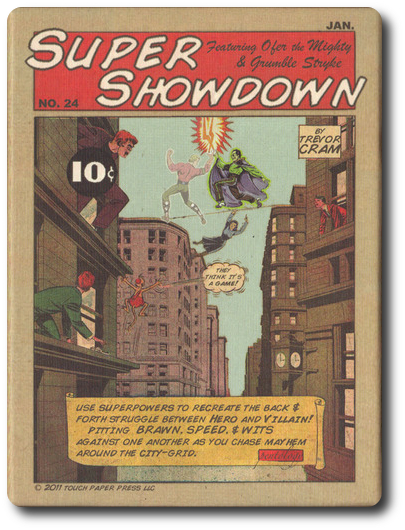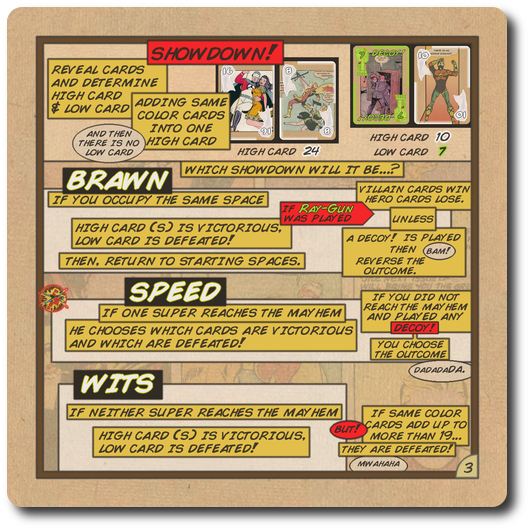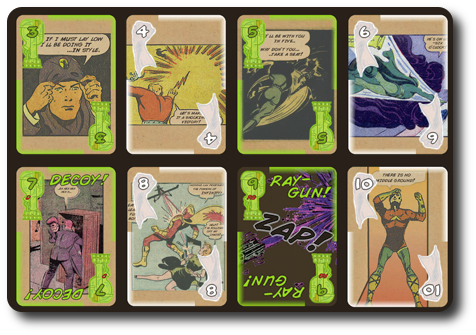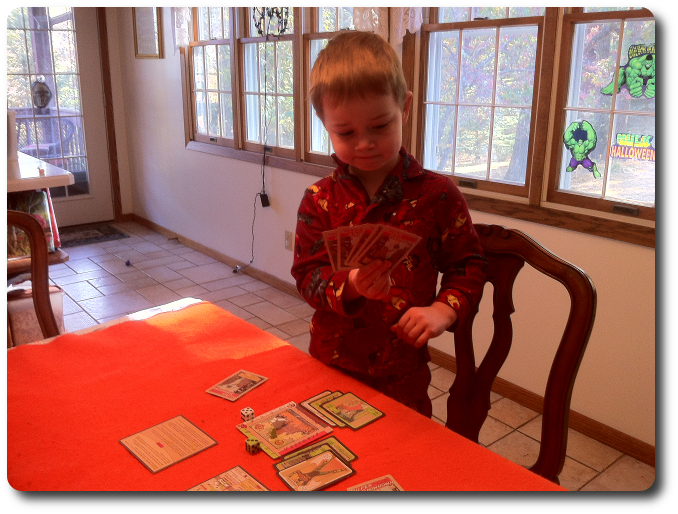
The Basics:
- For ages 5 and up (publisher suggests 12+)
- For 2 players
- Approximately 10 minutes to complete
Geek Skills:
- Counting & Math
- Logical & Critical Decision Making
- Reading
- Pattern/Color Matching
- Strategy & Tactics
- Risk vs. Reward
- Hand/Resource Management
Learning Curve:
- Child – Moderate
- Adult – Easy
Theme & Narrative:
- The epic battle between good and evil continues as two super rivals attempt to outwit and outmaneuver each other
Endorsements:
- Gamer Geek approved!
- Parent Geek approved!
- Child Geek approved!
Overview
The City: a great metropolis of people, activity, and commerce, but also a battlefield. Two individuals with super abilities claim ownership to the City’s streets and inhabitants, waging epic battles of brawn and wit. The Champion of the People is ever vigilant and keeps tabs on the greatest Villain the City has ever known, but the City is big. Too big for one super hero to fully defend. This the Villain knows and uses rumors to confuse the authorities and decoys to mislead and slow the super hero down. Soon, the sun will rise and the City will awake to a new day. As dawn approaches, two super rivals prepare for their upcoming showdown!
Super Showdown, by Touch Paper Press, is comprised of 18 Superpower cards, 2 six-sided die (1 white, 1 green), 1 white Hero meeple, 1 green Villain meeple, 1 City-Grid game board, and 2 Player Reference cards (double-sided). The quality of the components and printing is outstanding, but the real story is the thematic art direction. All artwork and game text was heavily influenced by the illustrations made popular during the Golden Age of comic books (1930’s to 1950’s). For those who are lovers of comics or nostalgic pop art, the game will be a visual feast. For those who are not, they might find the rule book and Player Reference cards to be a bit “busy”.

Example of the rules – Action Comic Book Style!
Game Set Up
To set up the game, first place the City-Grid game board in the middle of the playing area.
Second, shuffle the 18 Superpower cards and deal to each player 9 cards, face-down. Each player should now look at their hand, but keep it hidden from their opponent at all times. The player who has 5 or more white Superpower cards is the Hero and takes the Hero meeple. The player with 5 or more green Superpower cards is the Villain and takes the Villain meeple.
Third, the meeples are now placed on their starting location on the City-Grid game board. Each of the player’s starting locations are noted on the City-Grid by a white circle (starting location for the Hero) or a green circle (starting location for the Villain).
Fourth, the Hero player takes the white “Scanner” six-sided die and the Villain takes the green “Rumors” six-sided die. Each player should also take one of the Player Reference cards if they are not familiar with the game.
You are now ready to play! The Villain always starts first.
Super Rivalry
The game is played in rounds with each round being broken down into 6 sequential steps. The very first game round is always started by the Villain. After that, the players alternate who leads each round. This means the Hero starts the second round, then the Villain starts the third round, and so on until the endgame condition is met. For the sake of sanity, the player who is leading each of the phases is referred to as the “lead player”.
The sequential steps are as follows:
Step 1: Roll the Rumors/Scanner Die
If the Villain is the lead player, they will roll the green “Rumors” die and place the rolled results next to the green numbers on the City-Grid. If the Hero is the lead player, they will roll the white “Scanner” die and place the rolled results next to the white numbers on the City-Grid.

Step 2: First Move
The lead player now moves their meeple on the City-Grid. Movement is optional and done by moving the meeple 0, 1, or 2 spaces orthogonally along the City-Grid to an adjacent space. If the meeple starts from a “Powerboost” space (identified by a small colored circle), the player can move their meeple up to 3 spaces. After the lead player makes their move, the other player moves their meeple using the same rules.
Note that a meeple can never be moved if it shares the same location with the other meeple.
Step 3: Play Cards
Both players now select one of their Superpower cards in their hand and place it in front of them, face-down. Note that players will have both green (Villain) and white (Hero) Superpower cards. The players are always attempting to beat the other player’s number value on the card, but how they go about that is based on their final meeple location on the City-Grid. We’ll go over that in more detail during the Showdown phase.
The Superpower cards are numbered “1” to “18”, with all the white Hero Superpower cards having an even number value and all the green Villain Superpower cards having an odd number value. All previously played cards are visible on the table. Using this information and knowing what is in their own hand, a player can deduce what cards their opponent has and their overall potential strength.

Example of some of the cards in the game
To add a little bit of chaos to the battles, there is a Ray-Gun and Decoy card that can tip a showdown in a player’s favor, but only if they play them at the right time!
Step 4: Roll the Rumors/Scanner Die
The non-lead player now rolls their die and places it next to the matching number and color of the value rolled.
Step 5: Second Move
Players are now given a second chance to move their meeples on the City-Grid. Until step 4, the actual location of where the mayhem was occurring in the city was unknown. The police scanners reported trouble in the city, but didn’t have a fix on the exact location. Rumors hinted at a possible location, but were not specific. Now that both dice have been rolled, the exact location where the mayhem will occur is known to both players. Specifically, in the location where the row and column with dice intersect. Depending on what cards were played during step 3, players will either attempt to reach the mayhem, avoid it, or land on their opponent’s meeple.
Movement turn order is reversed for this step. The lead player moves their meeple second. For example, if the Villain is the lead player, the Hero will move their meeple first.
Step 6: Showdown!
Time for a super battle! Remember those cards that were played in step 3? Now they are flipped over and revealed to both players. Depending on the location of the meeples and the location of the mayhem, the results of the showdown will be different. There are three types of battles the super rivals can engage in. They are as follows:
A Battle of Brawn: if both players’ meeples are occupying the same location, the high card wins the round. Afterwards, both players return their meeples to their starting locations. Note that a Battle of Brawn can include two special cards. These are the Ray-Gun and the Decoy. If the Ray-Gun card is played, that player automatically wins the battle unless a Decoy card is played which cancels the Ray-Gun and reverses the outcome.
A Battle of Speed: if only one player’s meeple is occupying the mayhem location, that player chooses which card wins the round regardless of the number values on the cards. However, if the player who did not reach the mayhem location plays the Decoy card, they choose which card wins.
A Battle of Wits: if neither players’ meeples are located in the mayhem location or in the same location as each other, the high card wins the round. However, if the total value of both cards played is 19 or more, then both players are defeated (yes, they outwitted themselves).
Note: cards of the same color are added together and do not count as two separate card values.
The round is now over! After the showdown, the cards will be placed alongside the City-Grid in the Victory! or Defeated! locations. When adding cards to the piles, make sure they are face-up and all the numbers are visible. Players should now check to see if the game has ended. If not, a new round and showdown begins!
Endgame
The game immediately ends when one of the two players has 5 or more of their colored cards in the Victory pile or their opponent has 5 or more of their colored cards in the Defeated pile.
To learn more about Super Showdown, see the game’s official web site.
Prediction
At first glance, Super Showdown would appear to be just a comic book themed trick taking card game. For most of my players, this will be met with lukewarm excitement. Trick taking card games tend to follow a certain pattern of game play and seldom bring much to the table that is new or exciting. Dig a bit further and you start to see that there is much more to it. Oh, certainly the “trick taking” element is ever-present, but the use of the City-Grid and meeple placement puts a new twist on the hand management focus needed to win the game. This is what hooked me when I first read about Super Showdown and ultimately led me to support it on Kickstarter.
The rules of the game are easy and the steps for each round of play are very straightforward. Where I think my Child Geek group will have some issues is the meeple placement. This part of the game is rather abstract and plays a big part in what cards are played in a player’s hand. I will need to take the time to explain the importance of meeple placement to all the players to ensure they know how to leverage location during showdowns.
As I expected, the Child Geeks had several questions on the meeple placement. It became clear that the learning curve for Super Showdown was a bit steeper for the Child Geeks, which would explain the publisher’s recommended minimum age of 12+. But the game itself is not difficult and it only took the Child Geeks longer than the Parent and Gamer Geeks to understand the rules and feel comfortable enough with them to play. And so, as we set up our first game with my Child Geeks, I asked them their thoughts on Super Showdown so far.
“I like it, but I’m pretty sure I’m going to get confused about where I should put my meeple and how to use my cards.” ~ Liam (age 8)
“Can I be the Hero every time, Daddy?” ~ Nyhus (age 5)
Both of my super little geeks have their capes tied on, their gloves pulled tight, and their utility belts clicked. Let’s see if Super Showdown is an epic win or a just another trick taking card game.
Final Word
Both of my little geeks did well, but it took them 2 games each until they started to understand how the meeple placement on the City-Grid influenced card play. While in game terms that is 2 full games, it real-time, it only took them about 6 or so minutes. Games were fast and fun. The Child Geeks were visibly excited when they rolled the dice, moved their meeples, and played their cards. When the showdown revealed their cards, they rejoiced at their victories and shook their fists when defeated. Throughout the game, all the Child Geeks would use colorful comic and over the top dialog. For example, “Have at you!” and “Prepare for my Fists of Fury!” I spent the majority of my time working with my 5-year-old who turned out to be its biggest fan. He really wants to play Sentinels of the Multiverse, but the game is just a bit too advanced for him at this time. He saw Super Showdown as an excellent alternative and desperately wanted to play it, although the two games share nothing more than a common thematic element. Regardless, his tenacity and willingness to take the time to learn has resulted in my 5-year-old not only being able to play Super Showdown well, but well enough to beat his older brother and make older players stop and think about their moves when they go toe-to-toe with him on the City-Grid.
Epic win.
Parent geeks also enjoyed the game, but not so much when they played it with their peer group. Parent Geeks yearn for casual games that can be played in groups. To them, the biggest draw of a game comes from the socialization at the gaming table. Super Showdown, being only a 2-player game, does not provide for this type of experience. When the Parent Geeks played the game with their Child Geeks, however, they too were all smiles. Super Showdown gave the Parent Geeks an opportunity to play a fast game with their family whenever they liked that demanded little in the way of time or playing space. This pleased them a great deal. The non-gamers, on the other hand, didn’t care much for the game and found it to be confusing at first. Like the Child Geeks, the abstract battle ground of the City-Grid went over their heads. After only a few games, they understood its importance, but were never enthralled over the game’s theme, narrative, or the experience it provided.
Gamer Geeks were first drawn to the table by the game’s design. A Gamer Geek can smell the “production value” of a game a mile or so away and run towards it with reckless abandon. If you need proof, attend any convention and watch how they flock around games with lots of plastic pieces on big game boards. Once they were pitched the game and shown how it was played, the immediately saw that it was more than a trick taking card game, but not by much. They enjoyed how the City-Grid could be used to leverage a player’s Superpower cards for maximum effect and the level of strategy and tactics needed to out-think their opponent. Gamer Geek’s level of endorsement ranged from “OK” to “a neat surprise”. All positive with various levels of enthusiasm.

My little geek grunts as he suddenly realizes he might have played the wrong card – no, he didn’t – he won the game!
Gamer Geeks, this is a fast 2-player trick taking card game that allows the players to shift the power balance slightly through the City-Grid. While hand management is a must, you’ll find yourself thinking just as hard about where to place your meeples. The lowest valued cards can win a showdown against the highest valued cards if a meeple is placed correctly. There is always enough information at the table for the player to make an intelligent and informed game decision, but never enough to make the outcomes of the showdowns a forgone conclusion. This makes each round exciting and the fast paced game play keeps everything moving forward. This game is perfect for quick game fillers or whenever you are just looking for a fast and fun game to play with a friend.
Parent Geeks, while not enjoyed among your peers, the game was a hit when played against family members. The game plays fast and fun, giving each player a challenge but never overstays its welcome or feels too heavy. Your younger family members are going to be able to play this game, but only after a little bit of practice. The meeple placement is surprisingly important and I cannot overstate how badly a player will do if they don’t understand how the City-Grid influences the showdown. Once this game element is understood, everyone will enjoy this card game that provides excitement at your gaming table.
Child Geeks, it is worth your time to learn how to play this game. First of all, the game is fast and can be very exciting. This in itself should be enough to draw you in. Second, and much less exciting, the game strengthens some very important Geek Skills and is sure to make you a stronger and smarter player in any game you play. This is because the game makes you think ahead and then gives you the ability to somewhat control the outcome of each showdown based on new information. The level of thought needed to play this game competitively is surprisingly high, but each game play session is short and never taxes your brain to a point where it will melt. Learn how to play this game, Child Geeks!
Super Showdown continues to ride high in my Top 5 card games I always want to play. I always seem to find new and interesting ways to play it against opponents and have never had a game play session where I felt bored or didn’t enjoy myself. The City-Grid and the three different battle types in the showdown was a brilliant stroke of game design as it provided much-needed depth and elevates Super Showdown above and beyond your everyday trick tacking card game. Super Showdown requires more thinking and mental maneuvering than one would expect and this surprise has left Child, Parent, and Gamer Geeks happy and ready for more. Which is good news for me because I can’t get enough of this game.



